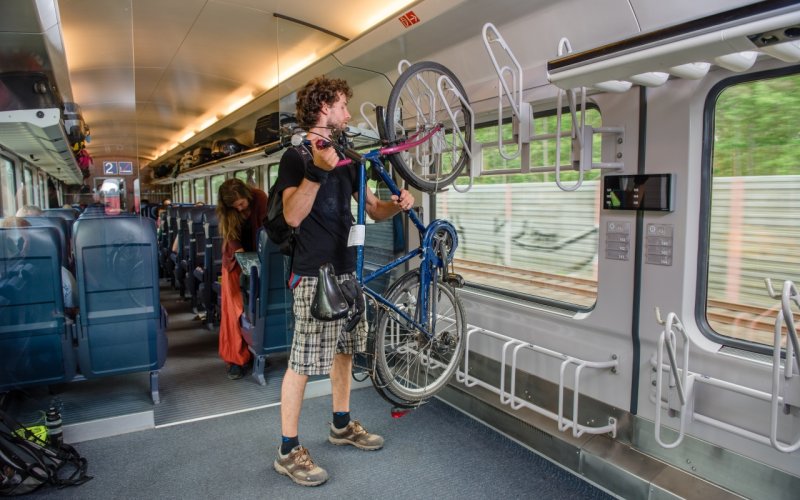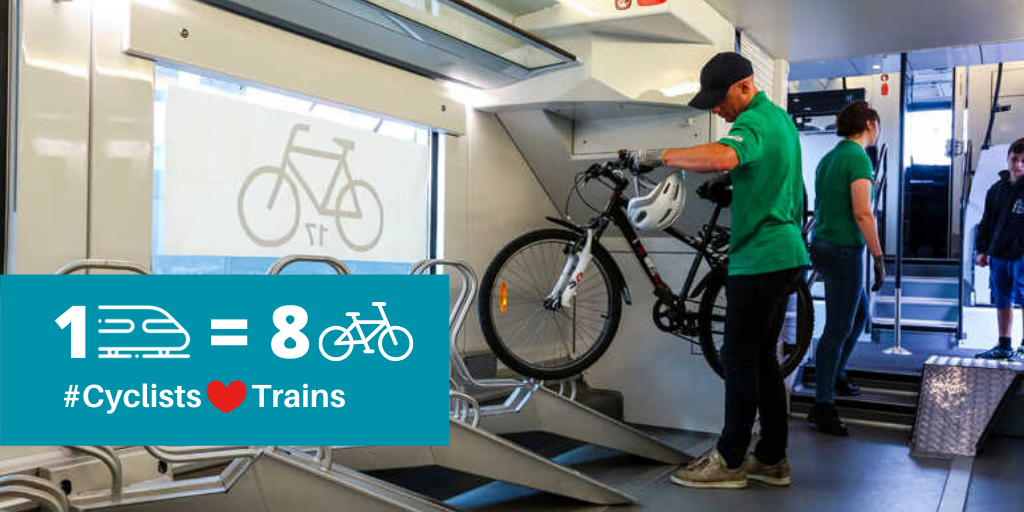
Better multimodality for greener mobility
By 2050, the European Commission has the ambition to make Europe the first net-zero carbon emission continent, as highlighted in the European Green Deal. It has also stressed the importance of multimodality, particularly regarding longer distances. The combination of train and bicycle is the most efficient and sustainable combination of transport modes to achieve these goals.
Train and bicycle – Let’s be the greenest combination
 Transport accounts for a quarter of the EU’s greenhouse gas emissions and its share continues to grow. A German study estimated that 27.4% of the emissions of the transport sector could be saved through an integrated and multimodal approach. The rail sector is committed in delivering the target of reducing transport greenhouse gas emissions by 90% by 2050 and to be the n°1 alternative to car and aviation transport. On 18 February 2020, the entire European rail sector gathered during the 13th edition of the European Railway Award Ceremony. High-level representatives of the European rail sector, and European decision makers, met to exchange ideas about the role of rail in a greener European mobility and insisted on multimodal transport as being the future of travel.
Transport accounts for a quarter of the EU’s greenhouse gas emissions and its share continues to grow. A German study estimated that 27.4% of the emissions of the transport sector could be saved through an integrated and multimodal approach. The rail sector is committed in delivering the target of reducing transport greenhouse gas emissions by 90% by 2050 and to be the n°1 alternative to car and aviation transport. On 18 February 2020, the entire European rail sector gathered during the 13th edition of the European Railway Award Ceremony. High-level representatives of the European rail sector, and European decision makers, met to exchange ideas about the role of rail in a greener European mobility and insisted on multimodal transport as being the future of travel.
“Are we moving fast enough to face the challenges of today?”, stressed Henrik Hololei, Director General of DG MOVE during a panel discussion. “We need to encourage multimodality. The challenge is there – the opportunities are even bigger […] E-bikes, bikes… all have a role to play as well”. Indeed, it is clear that the rail sector needs to work together with other mode of transports to achieve its own objectives.
Together, train and bicycle offer flexible and sustainable options for passengers, whether they are commuting or travelling, from the start to the end of their journeys.
When evaluating different transport modes, it is the bicycle that allows for important greenhouse gas savings. The ECF’s study Cycling more often 2 cool down the Planet!, shows that if levels of cycling in the EU-27 were equivalent to those found in Denmark, bicycle use would help achieve 12 to 26% of the 2050 target reduction set for the transport sector, depending on which transport mode the bicycle replaces. The EU will achieve its objective only by letting cycling play a major role by setting-up a comprehensive strategic framework, which could be based on the recommendations defined in the EU Cycling Strategy.
Train and bicycle – let’s make space for each other
Many cyclists would prefer to travel by train rather than by car or plane and yet, many trains still do not allow passengers to bring their bicycle on board. “We go to the mountain every summer and as there is no option to bring our bicycle on board on train, we are forced to go there by car”, sadly attested one user from France.
As cyclists are making space for trains, it is time for trains to make space for passengers with bicycles.
 Eight spaces for bicycles per train – a simple request to contribute facing complex challenges. During this first 2020 Semester, the EU Rail Passengers‘ Rights Regulation is being amended through the trialogues between the European Parliament, Commission and Council. This provides an opportunity to strengthen the wording related to bicycle carriage which is currently very weak. Unsurprisingly, many European services operate without sufficient capacity for cyclists (if any). Despite the differences in position between the three institutions, we expect that a compromise will be reached over the coming months. ECF’s campaign #TrainsForCyclists call for a minimum of eight bicycle spaces on every new and refurbished train will allow more complete, easy, efficient and sustainable journeys.
Eight spaces for bicycles per train – a simple request to contribute facing complex challenges. During this first 2020 Semester, the EU Rail Passengers‘ Rights Regulation is being amended through the trialogues between the European Parliament, Commission and Council. This provides an opportunity to strengthen the wording related to bicycle carriage which is currently very weak. Unsurprisingly, many European services operate without sufficient capacity for cyclists (if any). Despite the differences in position between the three institutions, we expect that a compromise will be reached over the coming months. ECF’s campaign #TrainsForCyclists call for a minimum of eight bicycle spaces on every new and refurbished train will allow more complete, easy, efficient and sustainable journeys.
Transportation is responsible for a quarter of all emissions in the EU, and it´s the only sector that has not reduced them since 1990. The good news is that today, 80% of Europeans are ready to replace their flights with trains and to walk or cycle for short distance trips. It is becoming a priority for the rail and the bicycle sectors to work together to come-up with efficient and sustainable options and solutions. 8 bicycles per train, a win-win strategy for both train operators and passengers, whether they are cyclists or not. It’s feasible - countries like Poland and Germany have already implemented this measure successfully so, what are we waiting for?

Regions:
Contact the author
Recent news!
Upcoming events
Contact Us
Avenue des Arts, 7-8
Postal address: Rue de la Charité, 22
1210 Brussels, Belgium









